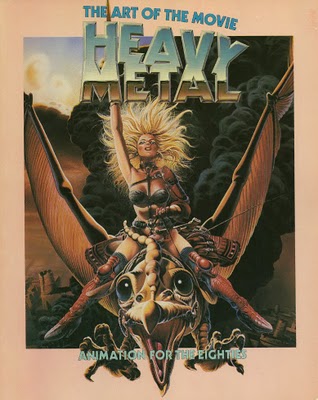Monday, January 18, 1982
QUALIFYING AS A Canadian film success story is Heavy Metal, the 1981 cartoon feature now reported to be returning a profit to its share-unit subscribers. Though no great hell as a motion picture, producer Ivan (Animal House) Reitman’s first venture into animated fantasy was a magnificent example of movie marketing. Contributing to the project’s economic success were a number of “tie-in” products, among them Carl Mecek's 128-page trade paperback, The Art of Heavy Metal: The Movie - Animation for the Eighties.Macek, who has been both an academic apologist for popular culture studies in California and a fllm studio publicist, has nothing but praise for Reitman's domestically [Canadian] financed film. His book, boasting “more than 100 illustrations! 80 pages in full color!” is a souvenir programme rather than a serious critical analysis, though.
To produce his text essay, Macek interviewed a number of the key animators employed on the project. Over and over again, he reports the same story.
Sequences were “made under extreme pressure” (p. 25), “in a period of only nine weeks” (p. 17) and “working against a tight deadline” (p. 86). “The one regret that everyone involved expresses is the lack of time” (p. 94). “Getting the nine-million-dollar-plus (sic) production to the theatres on time was the over-riding factor” (p. 89).
Missing from Macek’s heroic chronicle of deadline decision-making is any mention of why everybody was in such an unholy hurry. The answer to that fascinating question is contained in a private-press publication, Heavy Metal: The Prospectus, issued June 6, 1980.
At the time, the film was a pub1ic offering and potential investors were advised that “Principal Photography of the Film commenced on April 1, 1980 and is expected to be completed for certification purposes (emphasis added) by December 15, 1980.
“Subscribers will be entitled to deduct, in computing their income for tax purposes for the l980 taxation year, as capital cost allowance, up to 100% of the total capital cost of their Film Units provided that Principal Photography in respect of the Film is completed on or before December 31, 1980." (emphasis added)
Heavy Metal represented a risk of $7.3 million Canadian (not "$9 million-plus"). A good producer, Reitman was determined to protect his investors' backsides (or, more precisely, their down-sides).
Writing in the breathless style of a promoter, Mecek discusses each of the film’s eight episodes and offers some details of the technical problems and processes involved. As is often the case, the storyboard roughs, original character sketches and discarded designs are more interesting than the end product.
Macek’s enthusiasm for the film is boundless. For any readers who share his passion, he includes his Yorba Linda, Calif. business address. “A catalogue of the original art from the Heavy Metal movie is available . . . “
Tomorrow, we’ll review Elmer Bernstein’s recording of Heavy Metal — The Score.
The above is a restored version of a Province review by Michael Walsh originally published in 1982. For additional information on this archived material, please visit my FAQ.
AFTERWORD: Seen from our own age of computer-generated imagery (CGI) and high-tech special effects, Macek's enthusiasm for Heavy Metal as "Animation for the Eighties" seems almost quaint. For any Reitman biographer, though, his book is must reading. The Canadian producer is very much the hero of the story, and his role in bringing the film to fruition is chronicled in considerable detail.
IVAN REITMAN'S BIRTHDAY PACKAGE: Financing Heavy Metal (1980); Heavy Metal (1981) review; Heavy Metal - The Score (1982) music review.
